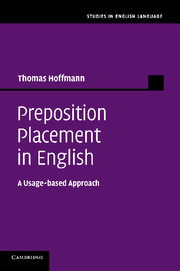Book contents
- Frontmatter
- Contents
- List of Figures
- List of Tables
- List of Abbreviations
- Acknowledgements
- 1 Introduction
- 2 Corroborating evidence: Data and methodology
- 3 Case notes: Independent factors
- 4 Evidence I: Corpus results
- 5 Evidence II: Experimental results
- 6 Preposition placement: The case for a Construction Grammar account
- 7 Conclusion: The verdict
- Online appendix
- References
- Index
5 - Evidence II: Experimental results
Published online by Cambridge University Press: 04 February 2011
- Frontmatter
- Contents
- List of Figures
- List of Tables
- List of Abbreviations
- Acknowledgements
- 1 Introduction
- 2 Corroborating evidence: Data and methodology
- 3 Case notes: Independent factors
- 4 Evidence I: Corpus results
- 5 Evidence II: Experimental results
- 6 Preposition placement: The case for a Construction Grammar account
- 7 Conclusion: The verdict
- Online appendix
- References
- Index
Summary
As the last chapter has shown, the examination of the Kenyan and British English components of the ICE corpus project already revealed a great number of processing-based as well as variety-specific constraints on preposition placement. Due to the inherent negative data problem of corpus evidence it was necessary, however, to corroborate some of the findings with experimental evidence. It was therefore decided to investigate the following issues in a series of introspection experiments using the Magnitude Estimation method:
(i) the status of pied-piping with that- and Ø-relativizers,
(ii) the status of pied-piping with the wh-words who and whom,
(iii) the alleged ungrammaticality of preposition stranding with certain PP types such as manner and frequency adjuncts,
(iv) the influence of syntactic complexity, and
(v) the acceptability of doubled preposition structures (the place in which I live in), a non-standard phenomenon for which it had only been possible to retrieve tokens from the ICE-EA corpus (cf. section 4.1).
The first experiment investigated issues (i) and (iii) in simple relative clauses (section 5.1), while the second one examined issues (i), (ii), (iv) and (v) in relative clauses of varying syntactic complexity (5.2). Finally, experiment number three focused on (ii), (iii) and (v) but this time tested these factors in interrogative clauses (5.3).
Preposition placement in simple relative clauses
The first experiment design crossed the following factors: preposition placement (two levels: stranded; pied-piped), relativizer (three levels: wh-; that; Ø) and pp type (three levels: prepositional verbs; temporal/locative sentence adjuncts; manner-degree/frequency-duration adjuncts).
- Type
- Chapter
- Information
- Preposition Placement in EnglishA Usage-based Approach, pp. 175 - 225Publisher: Cambridge University PressPrint publication year: 2011



